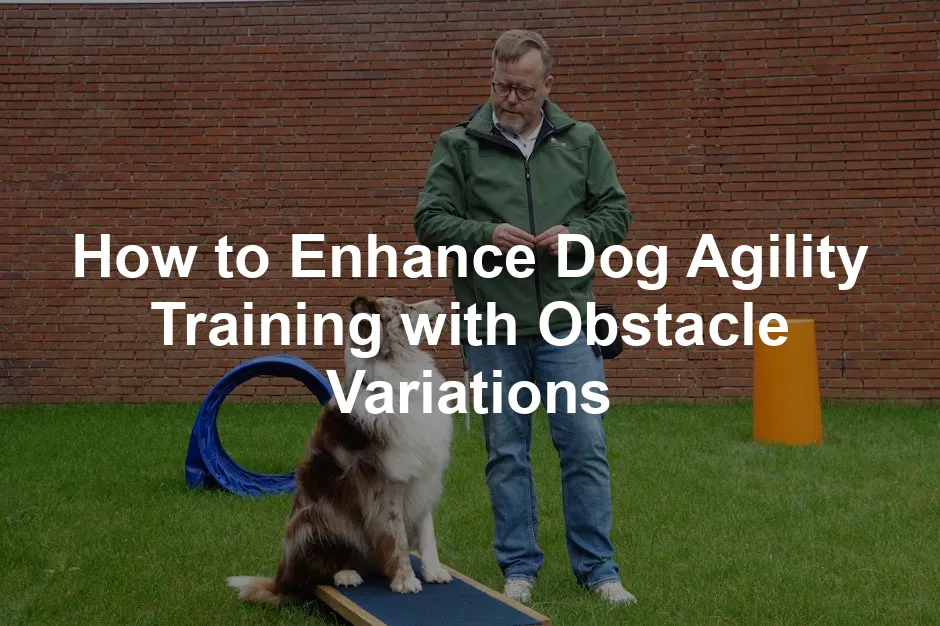How to Enhance Dog Agility Training with Obstacle Variations
Introduction
Dog agility training is a fun and rewarding sport. It promotes physical fitness and mental stimulation. Incorporating obstacle variations keeps training fresh and engaging. This not only improves your dog’s skills but also enhances their enthusiasm for learning.
To get started, consider investing in a Dog Agility Training Equipment Set. This set includes everything you need to set up a fun course in your backyard, making it easier to keep your dog active and engaged.
Summary and Overview
Dog agility training has gained immense popularity in recent years. Many dog owners appreciate its benefits, from exercise to bonding opportunities. By varying obstacles, you can significantly enhance training effectiveness. These variations help build your dog’s confidence, increase focus, and lead to better overall performance.
Obstacle variations challenge your dog in new ways. It breaks the monotony of routine exercises. This article aims to provide practical tips and techniques to optimize agility training through creative obstacle setups. You’ll discover how to keep your training sessions engaging and effective.
Benefits of Dog Agility Training
Engaging in dog agility training offers numerous physical and mental benefits for your furry friend. Physically, agility helps improve stamina, muscle tone, and weight management. This is especially important as over 40% of dogs are considered overweight. Regular activity through agility can combat obesity, ensuring your dog remains healthy.
Mentally, agility challenges keep dogs sharp and engaged. Dogs learn to navigate various obstacles, which stimulates their problem-solving skills. This mental stimulation is crucial for preventing boredom-related behaviors. Training also fosters better obedience, making dogs more responsive to commands and reducing anxiety.
Moreover, agility training strengthens the bond between you and your dog. Working together on tasks fosters teamwork and trust. This connection not only enhances training but also enriches your relationship. As you both navigate challenges, you’ll share rewarding experiences that deepen your bond.
Ultimately, the benefits of dog agility training are vast. From improved health to better behavior, it’s an investment in your dog’s well-being. Embracing agility training can make a significant difference in your dog’s life.

Understanding the Basics of Obstacle Training
Agility training involves various obstacles that challenge dogs physically and mentally. The most common types of agility obstacles are jumps, tunnels, and weave poles. Each serves a unique purpose and offers distinct challenges. Jumps help improve your dog’s leaping ability. Tunnels encourage speed and confidence as they navigate through them. Weave poles enhance coordination and precision.
When introducing obstacles, it’s crucial to do so gradually. Start with simple tasks before progressing to more complex ones. This approach helps your dog build confidence and skills without feeling overwhelmed. Remember, patience is key as your dog learns to navigate these challenges.
Types of Obstacles
- Jumps: These come in various heights and designs. They help develop your dog’s jumping technique.
- Tunnels: These can be straight or curved and encourage your dog to run through them.
- Weave Poles: A series of poles that dogs must weave in and out of. This obstacle improves agility and focus.
Safety Considerations
Before starting obstacle training, ensure your dog is physically ready. A vet check is advisable, especially for older or out-of-shape dogs. Gradual introduction to obstacles minimizes the risk of injury. Always monitor for signs of fatigue or discomfort during training sessions.
Basic Commands
It’s essential to establish basic commands before introducing obstacles. Commands like “sit,” “stay,” and “come” form the foundation of agility training. These skills help your dog understand what is expected during training and on the course.
A Dog Training Clicker can be a great tool to reinforce these commands and make training sessions more effective and fun!
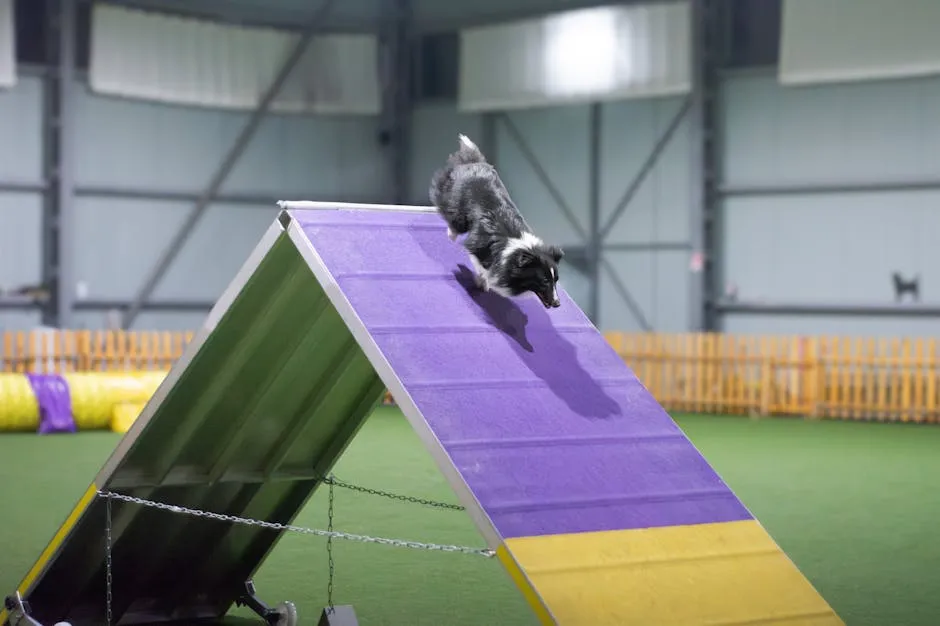
How to Create an Effective Obstacle Course
Designing an effective obstacle course requires careful consideration. Start by assessing the space available, whether in your backyard, a park, or indoors. The layout should promote both fun and challenge for your dog.
Space Requirements
Ensure you have enough room for each obstacle. A minimum space of 40 feet by 50 feet is ideal for a basic course. Larger areas allow for more complex setups and increased speed.
Equipment Selection
For beginners, start with simple, affordable equipment. Hurdles can be made from PVC pipes, while tunnels can be fabric or set up using garden hoses. These options are easy to find and can be modified as your dog progresses. Consider also getting a Dog Agility Tunnel for added fun and challenge!
Course Layout
Mix different obstacles to keep training interesting. For example, alternate jumps with tunnels and weave poles. This variation keeps your dog engaged and helps improve their adaptability. Consider using a sequence that gradually increases in difficulty, allowing your dog to build confidence as they learn.
Incorporate turns and angles to challenge your dog’s handling and decision-making skills. Regularly change the course layout to maintain excitement and interest during training sessions. By creating a dynamic obstacle course, you’ll keep your dog motivated and eager to learn.

Techniques to Vary Obstacle Training
To keep dog agility training exciting, varying obstacles is key. It enhances your dog’s skills and keeps them engaged. Here are some effective techniques to incorporate into your training sessions.
Change Height and Distance
Adjusting the height and distance of jumps can significantly challenge your dog. Start with lower jumps to build confidence. Gradually increase the height as your dog becomes more comfortable. Similarly, vary the distance your dog must jump. This keeps them guessing and encourages them to think critically during training. By changing these parameters, you can improve your dog’s jumping technique and overall agility.
Incorporate Different Surfaces
Using various ground materials can also enhance training. Grass, sand, rubber mats, or even gravel can change how your dog interacts with obstacles. Different surfaces can provide unique challenges and improve your dog’s balance and coordination. For instance, jumping on sand can be more challenging than on grass. Make sure to introduce each surface slowly, allowing your dog to adapt and build confidence with every training session.
Consider using a Dog Cooling Mat for those hot days when your furry friend needs a break after a training session!

Adding Complexity
Combining obstacles adds another layer of challenge. Set up sequences that require your dog to navigate multiple obstacles in a row. For instance, after a jump, have them run through a tunnel and then weave between poles. This combination helps your dog learn to make quick decisions. It also improves their ability to follow your cues. Start with simple combinations and gradually increase the complexity as your dog becomes more skilled.
By employing these techniques, you can keep your dog agile and engaged. The variety in training not only sharpens their skills but also strengthens your bond. Keep experimenting with different combinations and watch your dog’s agility soar!
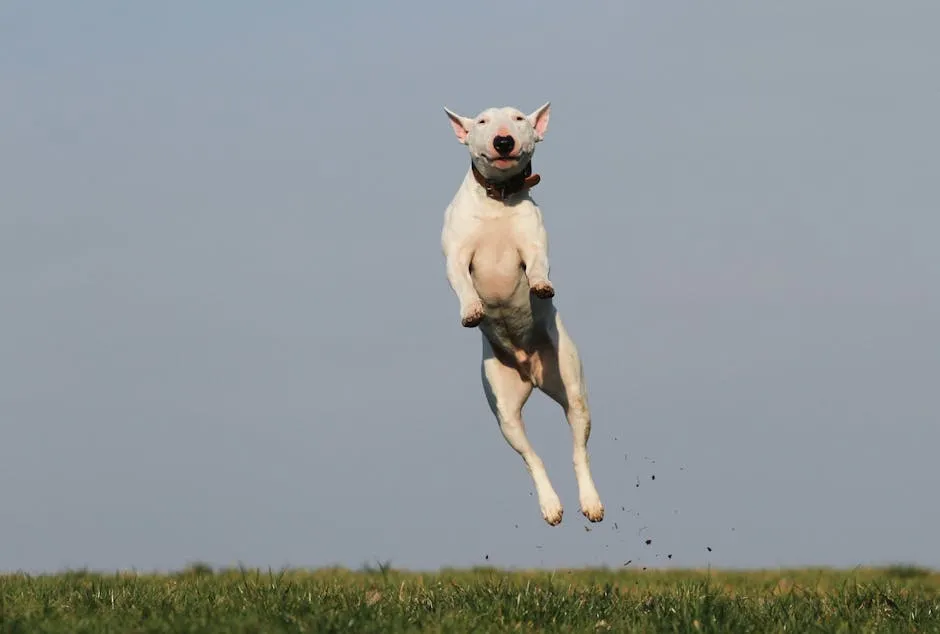
Advanced Obstacle Training Strategies
Once your dog has mastered the basics, it’s time to introduce advanced strategies for agility training. These methods will push your dog’s skills further and improve their performance.
Handling Techniques
Effective handling is crucial for guiding your dog through complex courses. Use clear cues and body language to signal your dog’s next move. Practice running alongside your dog, maintaining eye contact to keep them focused. Position yourself strategically to lead your dog through challenging sequences. This connection between you and your dog is essential for successful agility runs.
Distance Training
Building your dog’s independence is vital. Distance training allows your dog to navigate obstacles without relying on your presence. Start by sending your dog to a jump from a distance. Gradually increase the distance as they gain confidence. This practice not only enhances their decision-making skills but also builds their trust in you as a handler.
Timed Runs
Incorporating timed runs can simulate competition conditions. Set up a course and time your dog as they navigate it. This adds an element of urgency and encourages them to perform at their best. Record their times to track progress, and challenge them to improve. Timed runs can also help your dog learn to focus under pressure, a crucial skill for competition.
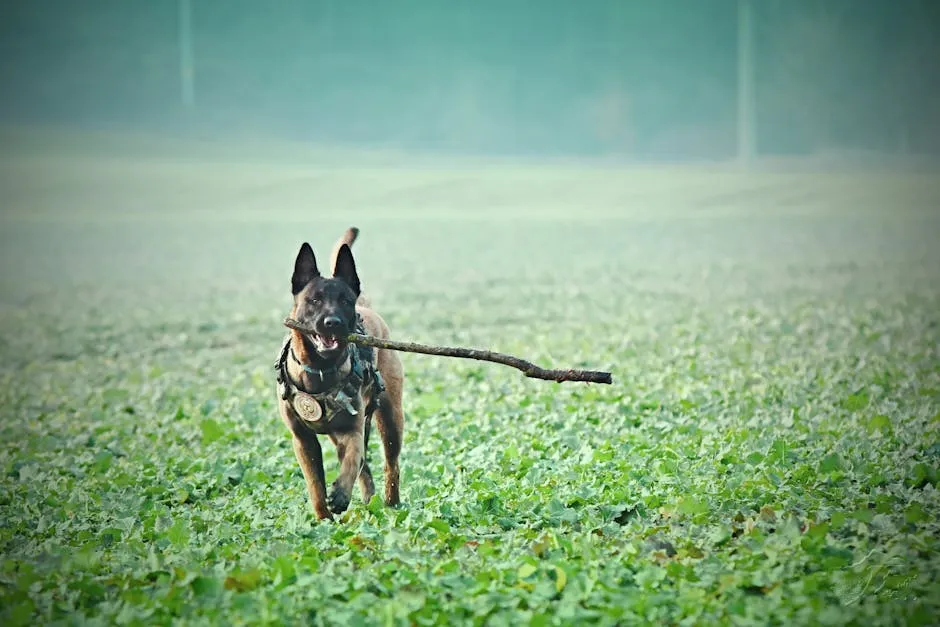
Common Challenges and Solutions in Obstacle Training
Training with obstacles can be incredibly rewarding, but it also comes with its own set of challenges. Recognizing these issues early can help you overcome them effectively. Here are some common problems and practical solutions to enhance your dog’s agility training.
Fear of Obstacles
Many dogs struggle with fear when approaching new obstacles. This can lead to hesitation or refusal to participate. To build confidence, start with low-pressure environments. Introduce obstacles gradually, allowing your dog to investigate them at their own pace. Use treats and praise to create positive associations. You might also consider using familiar toys or treats to encourage your dog to engage with the obstacle. Consistency and patience are key here.
For those moments when you need a little extra motivation, try using a Interactive Dog Toy. These toys can help distract and engage your dog during training sessions!
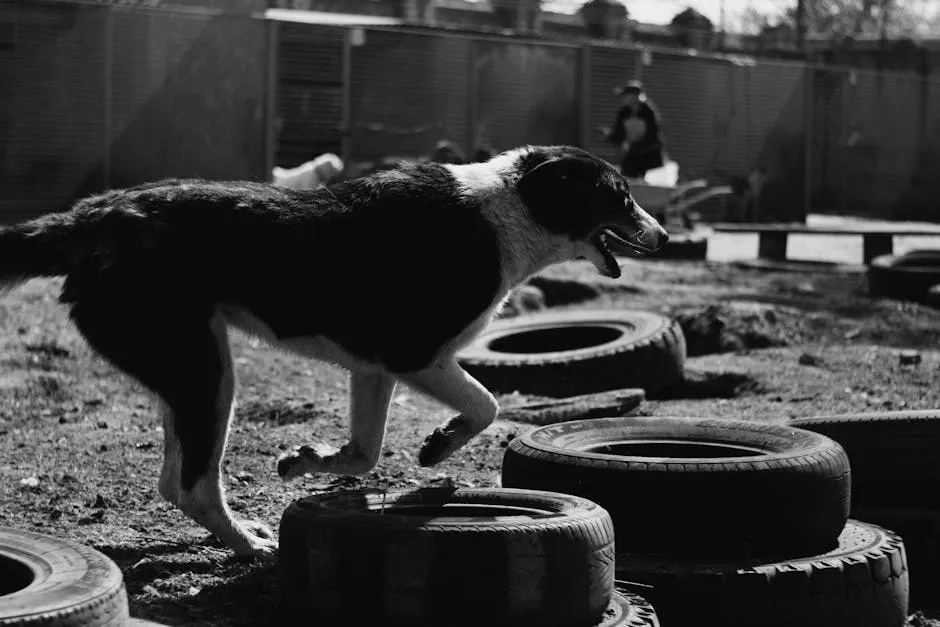
Lack of Focus
Distractions can easily pull your dog’s attention away during training. To improve focus, practice in a quiet area before gradually introducing distractions. Use short training sessions to keep your dog engaged. Incorporate fun games that require attention, such as hide-and-seek with treats. Training with a partner can also help; one person can manage distractions while the other focuses on the dog. Reinforcing focus through commands like “look” or “watch me” can further enhance attention.
Physical Limitations
Older dogs or those with injuries may find traditional obstacles challenging. To accommodate their needs, consider modifying obstacles. Use lower jumps or wider tunnels to make them more accessible. Ensure that your training sessions are short and not overly strenuous. Regular breaks can help manage fatigue. Additionally, consult with a veterinarian to ensure your dog’s safety during training. Adjusting your training plan to fit your dog’s physical capabilities will allow them to enjoy agility without strain.
To ensure your dog is always prepared, consider having a Pet First Aid Kit on hand. It’s always better to be safe than sorry!

Conclusion
In summary, enhancing dog agility training with obstacle variations is crucial for improving performance and keeping your sessions engaging. By addressing common challenges, you help your dog feel more comfortable and focused. Don’t hesitate to try different techniques and obstacles, as they can lead to exciting discoveries for both you and your dog. Enjoy the training process and watch your dog thrive!
FAQs
What are the benefits of dog agility training?
Dog agility training offers fantastic benefits for both you and your furry companion. It enhances your dog’s physical fitness, improving stamina and muscle tone. This activity promotes weight management, which is crucial since many dogs struggle with obesity. Engaging in agility also strengthens the bond between you and your dog. Working together fosters teamwork and trust, making your relationship more rewarding. Plus, it provides mental stimulation, keeping your dog sharp and focused.
How can I start with basic agility training at home?
Starting agility training at home is easier than you think! Begin with basic commands like “sit,” “stay,” and “come.” These skills form the foundation for agility tasks. Set up simple obstacles using household items, like broomsticks for jumps or boxes for tunnels. Gradually introduce your dog to these obstacles, rewarding them with treats and praise. Keep sessions short and fun to maintain their interest. Consistency is key; practice regularly to build confidence and skills.
What types of obstacles are commonly used in agility training?
Agility training features a variety of obstacles, each with its own purpose. Common types include jumps, tunnels, weave poles, and seesaws. Jumps help improve your dog’s leaping ability, while tunnels encourage speed and confidence. Weave poles enhance coordination and precision, forcing dogs to navigate through them closely. Seesaws teach balance and control. Mixing these obstacles in your training keeps sessions exciting and helps develop different skills.
How can I help my dog overcome fear of certain obstacles?
Building confidence in your dog is essential for overcoming fear of obstacles. Start by introducing them to obstacles in a low-pressure environment. Allow your dog to explore each obstacle at their own pace. Use treats and praise to create positive associations. Gradually increase exposure to challenging obstacles as their confidence grows. Patience is crucial; avoid forcing your dog. Celebrate small victories, and soon your dog will tackle those fears with enthusiasm.
Is there an age limit for dogs to start agility training?
Agility training can be suitable for dogs of various ages. Puppies can start with basic skills and socialization, but heavy training should wait until they are fully grown. For older dogs, agility can be beneficial if adjusted for their physical condition. Consult your veterinarian to ensure your dog is fit for agility training. Tailor exercises to their age and health, allowing them to enjoy the activity safely.
Can mixed-breed dogs participate in agility training?
Absolutely! Mixed-breed dogs can excel in agility training just like purebreds. The key is to assess your dog’s temperament and physical capabilities. Any healthy dog with good energy can participate. Agility training offers a wonderful opportunity for all dogs to bond with their owners and develop skills. So whether your dog is a mutt or a purebred, agility can be a fun and engaging activity for both of you.
Please let us know what you think about our content by leaving a comment down below!
Thank you for reading till here 🙂
For more information on effective training techniques, check out this comprehensive guide on training techniques for deaf or blind dogs.
All images from Pexels

